Across Montana’s varied landscapes, from its expansive prairies to its dense forests and towering mountain ranges, a captivating collection of owls thrive. The owl species found in Montana range from the small Northern Pygmy Owls to the imposing Great Horned Owls, each exhibiting unique behaviors and adaptations in line with their specific habitats.
Montana’s Owls
| Owl Species | Frequency in Montana | Presence in Montana | Specific Locations in Montana |
|---|---|---|---|
| Great Horned Owl | Common | Year-round | Throughout the state |
| Eastern Screech Owl | Rare | Year-round | Eastern Montana, river valleys |
| Western Screech Owl | Uncommon | Year-round | Western Montana, river valleys |
| Barred Owl | Uncommon | Year-round | Western Montana, riparian forests |
| Barn Owl | Uncommon | Year-round | Farmland, open grasslands |
| Long-eared Owl | Uncommon | Year-round | Dense stands of trees near open areas |
| Short-eared Owl | Uncommon | Breeding season | Grasslands, marshes |
| Northern Saw-whet Owl | Uncommon | Year-round | Forested areas, particularly north |
| Snowy Owl | Rare | Winter | Open, treeless areas |
| Boreal Owl | Uncommon | Year-round | High-elevation conifer forests |
| Great Gray Owl | Uncommon | Year-round | Dense coniferous forests |
| Northern Pygmy Owl | Uncommon | Year-round | Montane forests |
| Flammulated Owl | Uncommon | Breeding season | Ponderosa pine forests |
| Burrowing Owl | Uncommon | Breeding season | Grasslands with burrows |
| Northern Hawk Owl | Rare | Winter | Boreal forests, occasionally south |
Owl Species Found in Montana
Great Horned Owl (Bubo virginianus)
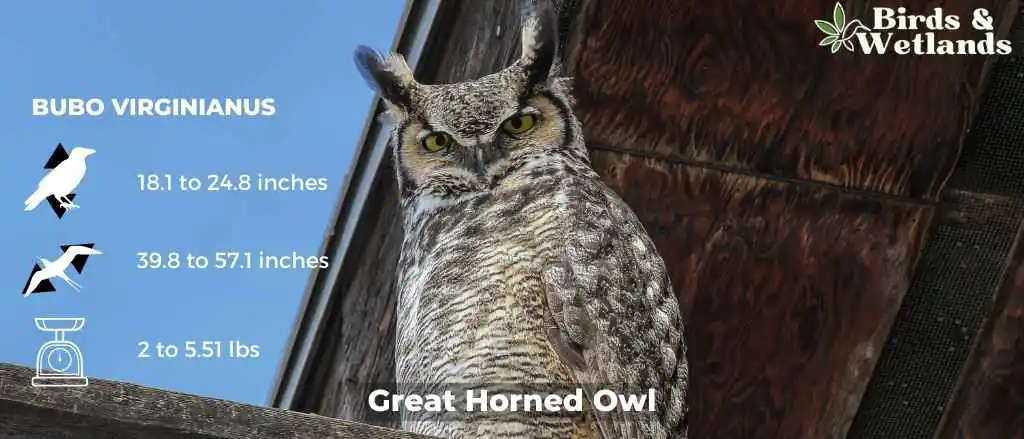

Great Horned Owl Sound
Scientific Name:Bubo virginianus
Length: 18.1-24.8 in
Wingspan: 39.8-57.1 in
Weight: 32.1-88.2 oz
The Great Horned Owl is a large owl with long wings and a large head. It’s one of the most common owls in North America.
Great Horned Owls are large, stocky birds with soft feathers that are gray to brown on their backs and white on their chests. Their faces are characterized by two black “ear” tufts, which can be raised or flattened depending on the owl’s mood. The eyes are yellow, orange, or red in color.
The habitat of the Great Horned Owl is a variety of different environments such as forests and deserts. They also live near water sources such as lakes, streams and rivers where they can hunt for fish.
The diet of the Great Horned Owl consists primarily of small mammals such as mice and rats; however they will also eat other rodents such as squirrels, rabbits and porcupines. They have been known to eat skunks too.
Eastern Screech-Owl (Megascops asio)
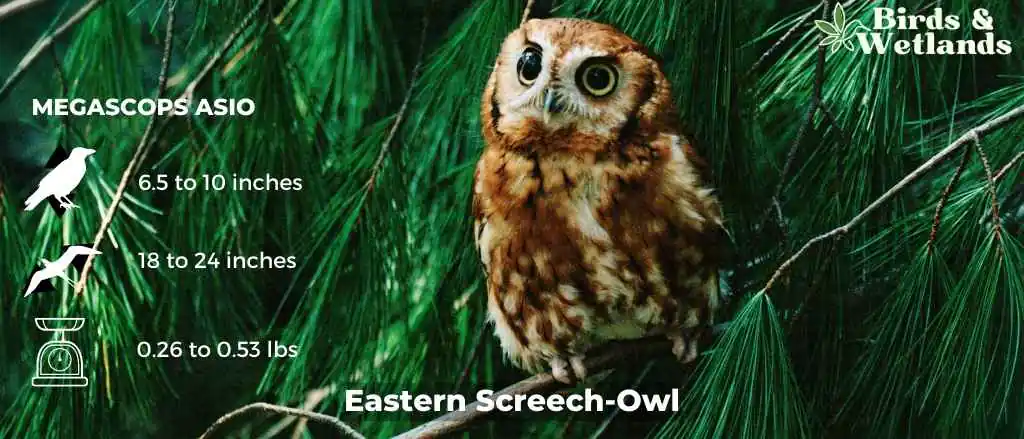
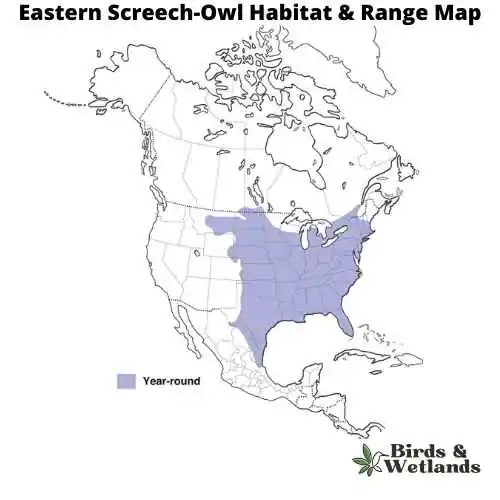
Eastern Screech-Owl Sound
Scientific Name: Megascops asio
Length: 6 to 10 in
Wingspan: 8 to 24 in
Weight: 4 – 8.5 oz
The Eastern Screech-Owl is a small owl species native to most wooded environments of the eastern half of North America, from the Canadian provinces to Florida and Texas.
Eastern Screech-Owls are relatively small and exhibit a complex pattern of gray or reddish-brown coloration, which provides excellent camouflage against tree bark.
These owls are known for their distinctive call, which is often described as a haunting trill or a whinny-like sound. Despite their name, they do not actually produce a “screech.”
Eastern Screech-Owls feed on a variety of prey, ranging from small mammals and birds to insects and even earthworms. It is primarily nocturnal, hunting at night from a low perch and swooping down onto prey.
Eastern Screech-Owls nest in tree cavities or abandoned woodpecker nests, but they readily adapt to nesting boxes where natural cavities are not available. They typically lay between 2 to 6 eggs, which are incubated primarily by the female.
Western Screech-Owl (Western Screech-Owl)
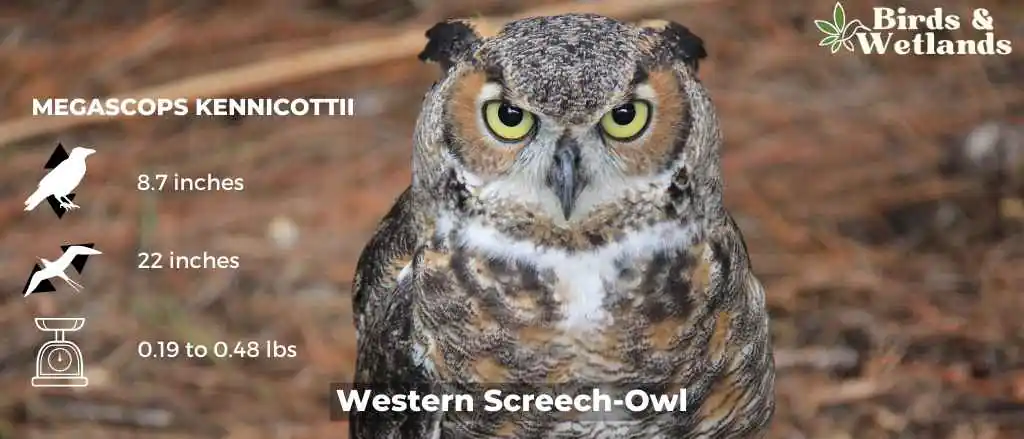
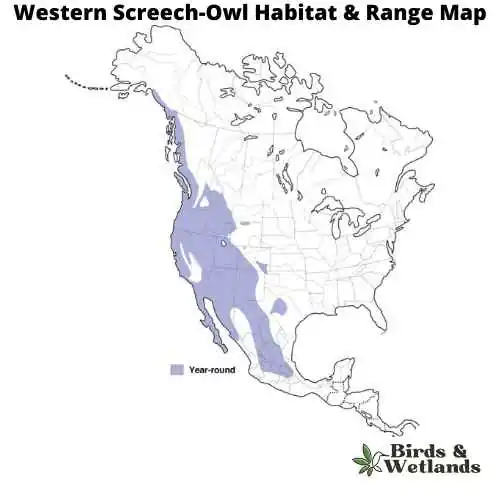
Western Screech-Owl Sound
Scientific Name: Megascops kennicottii
Length: 22 cm (8.7 in)
Wingspan: 55 cm (22 in)n
Weight: 88 to 220 g (3.1 to 7.8 oz)
The Western Screech-Owl, or Megascops kennicottii, is a small species of owl native to North and Central America. Western Screech-Owls are nocturnal predators, and its diet primarily consists of small mammals, birds, insects, and occasionally fish.
This owl is medium-sized compared to other screech-owls. It has a compact, stocky body, and is often recognized by its large head with yellow eyes surrounded by greyish-brown facial disks. The plumage is generally a mixture of grey and brown, with intricate patterns of spots and streaks that provide excellent camouflage against tree bark.
These owls prefer mixed woodland habitats, including deciduous forests and semi-open areas with trees. They often nest in tree cavities, but will also readily take to nest boxes if available. These birds are primarily non-migratory, and once they’ve established a territory, they tend to stay within the same area year-round.
Barred Owl (Strix varia)
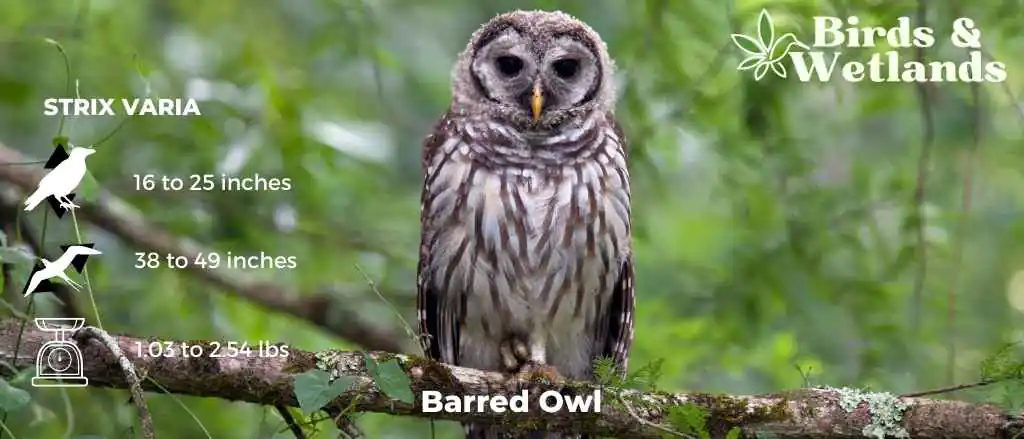

Barred Owl Sound
Scientific Name: Strix varia
Length: 40 to 63 cm (16 to 25 in)
Wingspan: 96 to 125 cm (38 to 49 in)
Weight: 468 to 1,150 g
The Barred Owl is a medium-sized owl with a barred pattern on its chest and belly. They have large yellow eyes that allow them to see well in low light conditions. Their ears are not very large which means they do not hear very well but they have excellent hearing abilities which allow them to detect sounds up to 1 mile away. Their feathers are brown and streaked with white, and they have black bars on their chests and wings.
Their habitats include forests, woodlands, orchards, parks, farmland and suburban backyards.
Barred Owls (also known as hoot owl) eat small mammals such as mice, rats and squirrels. They also eat insects such as beetles or grasshoppers. These owls hunt during the day when it is light out so that they can see their prey better than at night when they would be using senses other than sight like sound or smell to find their food source.
Barred owls are monogamous birds which means they mate for life. They build nests in trees or cavities on the ground and lay 2-4 eggs per year. The incubation period for these eggs lasts about 28 days before hatching takes place.
Barn Owl (Tyto alba)

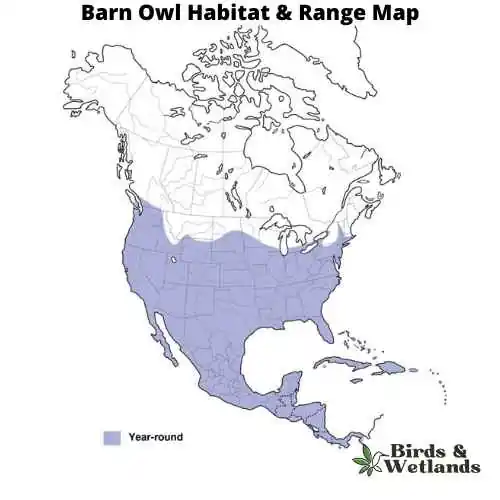
Barn Owl Sound
Scientific Name: Tyto alba
Length: 13 to 15 in
Wingspan: 31 to 37 in
Weight: 9.2 oz
The Barn Owl is a widespread species of owl known for its distinctive heart-shaped facial disc.
Barn Owls are medium-sized owls, they are pale overall with golden-brown wings and back, contrasted by a white face, chest, and belly. Their most notable feature is their heart-shaped facial disc, which helps channel sound to their ears.
Barn Owls are typically found in open habitats, including farmland, woodland, and marshes. They are named for their habit of nesting in human structures such as barns, church towers, and in the hollows of large trees. These owls are nocturnal, hunting at night and roosting during the day.
The diet of Barn Owls primarily consists of small mammals, particularly rodents such as mice and rats. They are known for their silent flight, which allows them to sneak up on their prey without detection.
Barn Owls have a unique nesting behavior. They do not build nests, but instead, lay their eggs directly on the bare surface of a secluded ledge or cavity. A female typically lays 4-7 eggs, and both parents help incubate the eggs and care for the chicks.
The long-eared owl (Asio otus)
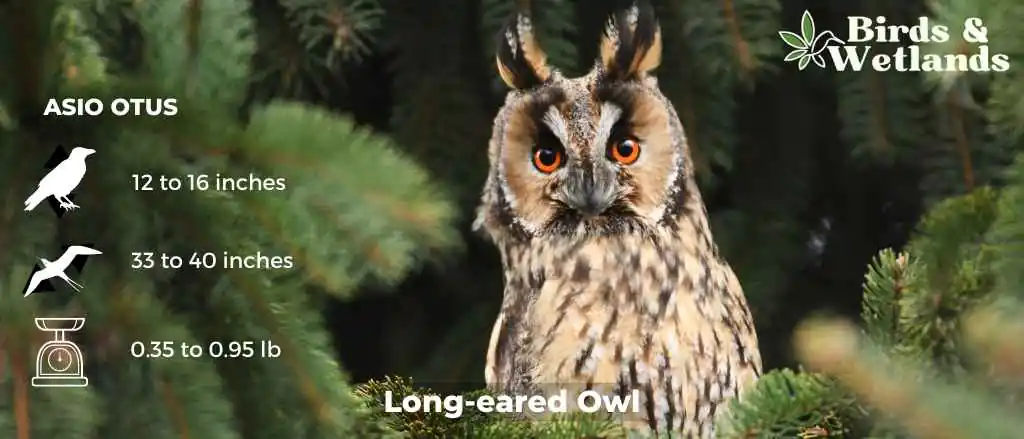

Long-eared Owl Sound
Scientific Name: Asio otus
Length: 12 and 16 in
Wingspan: 2 ft 10 in to 3 ft 4 in
Weight: 5.6 to 15.3 oz
The Long-eared Owl is a medium-sized owl species known for its distinctively long ear tufts, which can be raised or lowered depending on the bird’s mood or intention.
Long-eared Owls have mottled brown and cream plumage, which provides excellent camouflage among the trees. Their most distinctive features are their long, black-tipped ear tufts, which are set closer to the center of the head than in most other owl species.
These owls inhabit a wide variety of habitats, including deciduous and coniferous forests, woodlands, and even semi-deserts.
The Long-eared Owl’s diet primarily consists of small mammals, especially voles, but they will also take small birds and insects. They are skillful hunters, often capturing prey from a perch or in flight.
In terms of nesting behavior, Long-eared Owls do not construct their own nests, instead they take over old nests built by other bird species, usually those of corvids or other large birds. They lay an average of 4 to 5 eggs, which are incubated by the female while the male provides food.
Short-eared Owl (Asio flammeus)
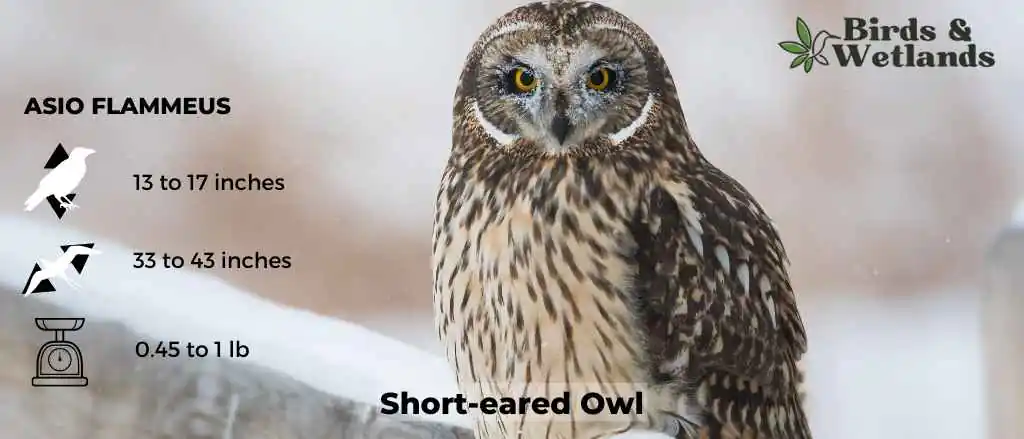
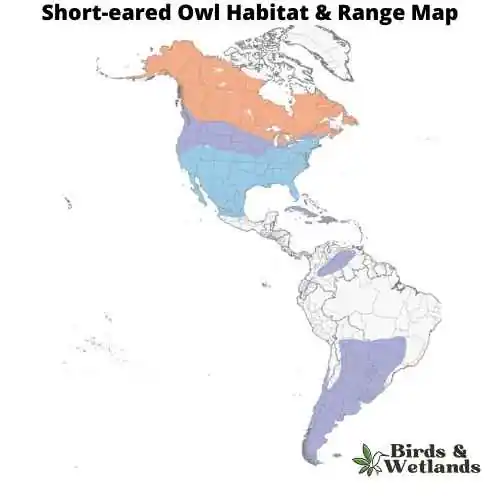
Short-eared Owl Sound
Scientific Name: Asio flammeus
Length: 13–17 in
Wingspan: 33 to 43 in
Weight: 7.3–16.8 oz
The Short-eared Owl is a medium-sized owl species with a wide distribution, found across North and South America, Europe, Asia, and many Pacific islands. Despite its name, the “ears” of the Short-eared Owl are not often visible, as they are small and tend to blend with the bird’s feathers.
The owls are predominantly brown with buff and white accents throughout their body and wings, and dark patches around their yellow eyes.
Short-eared Owls diet consists largely of small mammals, especially voles. However, they are opportunistic hunters and will also prey on a variety of other animals, including other birds, when available.
Their habitat is characterized by open areas like grasslands, marshes, and tundra. They nest on the ground, which is unusual for owls, and this makes them vulnerable to ground predators. As such, they often live in areas with tall grasses or other ground cover for protection.
Northern Saw-whet Owl (Aegolius acadicus)
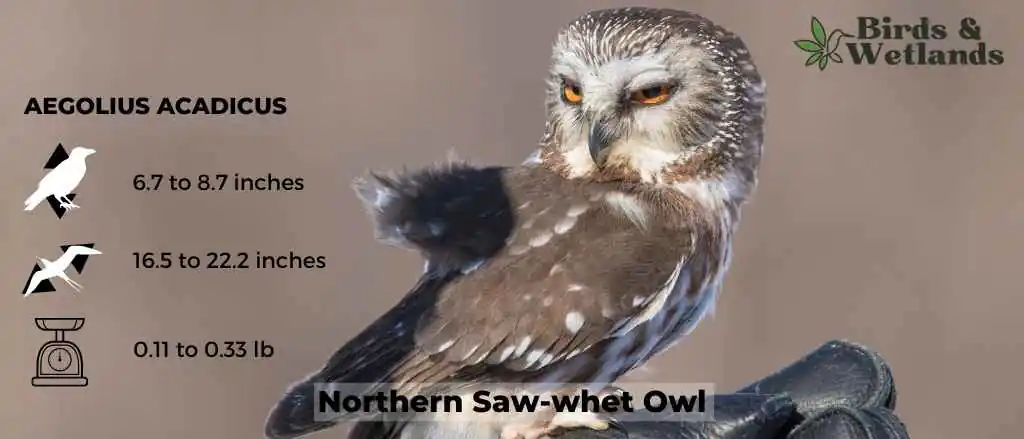

Northern Saw-whet Owl Sound
Scientific Name: Aegolius acadicus
Length: 17–22 cm (6.7–8.7 in)
Wingspan: 42–56.3 cm (16.5–22.2 in)
Weight: 54 to 151 g (1.9 to 5.3 oz)
The Northern Saw-whet Owl is a tiny, speckled gray owl and it’s one of the smallest owls in North America. It’s also known as the Little Owl or Wood Owl in some areas.
Northern Saw-whet Owls have dark brown eyes, white eyebrows, and yellow beak. It has brownish-grey feathers that are spotted with white. The owl’s legs are covered in feathers and appear nearly invisible when the bird is perched on a branch or tree.
In the winter they migrate south to warmer climates. They prefer to live in dense coniferous forest with large trees but will occasionally nest in shrubs or other vegetation that can protect them from predators.
The Northern Saw-whet Owl eats mice and voles (small rodents), small birds, frogs, salamanders, moles and shrews, but unlike most owls they chop their prey up and spread over a few meals. They will also eat insects like beetles and grasshoppers if they are available. It hunts from a perch at night using its excellent hearing to locate prey items within about 30 feet (9 meters) of its nest.
These owls nest in tree cavities usually located close to water sources such as lakes or rivers where they can find their food source (insects). They lay 2-4 eggs at one time which incubate for about 30 days before hatching.
Snowy owl (Bubo scandiacus)

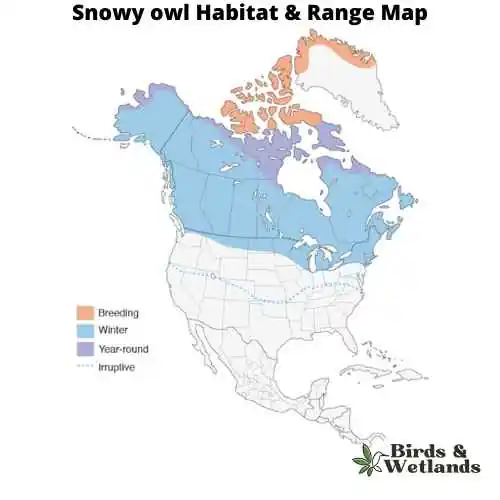
Snowy owl Sound
Scientific Name: Bubo scandiacus
Length: 20.7 to 28 in
Wingspan: 3 ft 10 in to 6 ft 0 in
Weight: 3.2lb to 5.3lb
The Snowy Owl, is of the most well-known species of owls, the Snowy Owl is renowned for its striking appearance and adaptations to its extreme environment.
Snowy Owls are medium sized birds that possess a rounded head, yellow eyes, and a black beak. The most distinctive feature of the Snowy Owl is its white plumage, which provides effective camouflage in its snowy habitat. Male Snowy Owls are often almost completely white, while females and younger owls have more extensive dark barring on their plumage.
Unlike many owl species, Snowy Owls are primarily diurnal, which means they are active during the day. This is an adaptation to life in the Arctic, where there can be 24 hours of daylight in the summer. Their diet mainly consists of small mammals, particularly lemmings, but they are known to eat a variety of animals including birds, fish, and even carrion when necessary.
Snowy Owls nest on the ground, usually on a mound or boulder. Their breeding success is closely tied to the availability of food, and in good years a single pair of owls can raise a large brood of chicks.
Boreal Owl (Aegolius funereus)
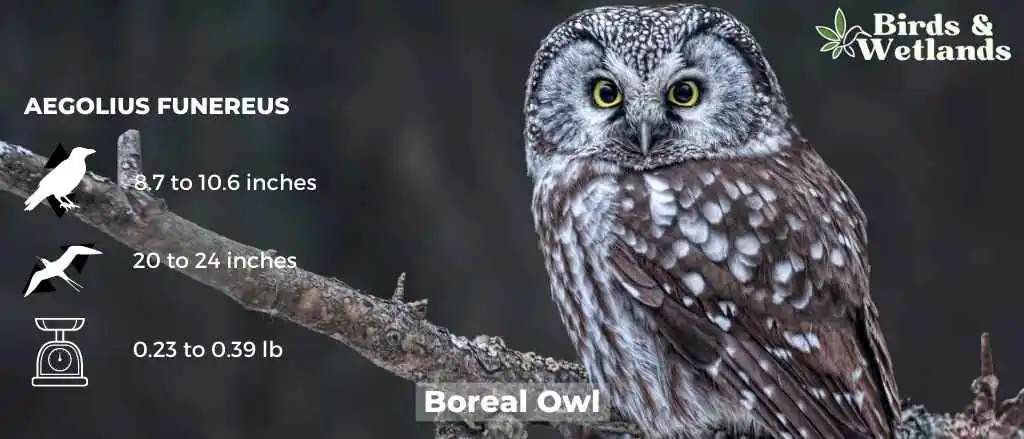
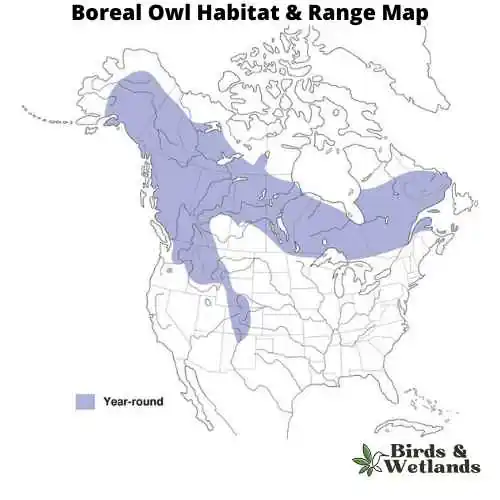
Boreal Owl Sound
Scientific Name: Aegolius funereus
Length: 8.7–10.6 in
Wingspan: 20–24 in
Weight: 3.8 oz–6.3 oz
The Boreal Owl, also known as Tengmalm’s Owl, is a small yet captivating nocturnal bird found predominantly in the northern hemisphere’s boreal forests, hence its name.
The Boreal Owl is petite in size, its plumage is predominantly grayish-brown, with white spots sprinkled on the upper parts and pale streaks on the underside, which lends a mottled effect. The bird’s rounded head, lack of ear tufts, and large yellow eyes are characteristic traits of this species.
Boreal Owls have a distinctive call, described as a series of soft, low hoots, which can often be heard during the cold winter months. As strictly nocturnal birds, they rest during the day, usually in tree cavities or similar concealed spots, and become active at night.
These owls are remarkable hunters, feeding mainly on small mammals such as voles and shrews, although they have been known to consume small birds when available. Their exceptional hearing allows them to locate prey under the snow in the darkest of nights.
Great Gray Owl (Strix nebulosa)


Great Gray Owl Sound
Scientific Name: Strix nebulosa
Length: 26 in to 28 in
Wingspan: 56 to 60 in
Weight:2.2 lb to 2.85lb
The Great Gray Owl, or Strix nebulosa, is a very large owl, native to the boreal forests across North America and Eurasia. Despite its great size, it’s more so known for its impressive appearance rather than its weight, as it is outweighed by several other large owl species.
The Great Gray Owl has a large, rounded head with a grey face and yellow eyes, surrounded by concentric circles of dark and light feathering. It is known for its bow-tie-shaped white moustache stripe and black chin spot.
One of the distinguishing characteristics of this owl is its elongated tail, which makes it appear much larger than it actually is. The plumage is mostly grey with a unique pattern of fine white, gray, and brown streaks and bars. Despite its large size, its diet primarily consists of small rodents, like voles and pocket gophers.
Great Gray Owls prefer dense coniferous forests, often near open meadows or bogs. Rather than building their own nests, they typically use nests previously built by other large birds, such as hawks or crows. They also occasionally nest in broken-top trees or on man-made structures.
Northern Pygmy-Owl (Glaucidium gnoma)


Northern Pygmy-Owl Sound
Scientific Name: Glaucidium gnoma
Length: 7 – 7 1/2 in)
Wingspan: 14.5 – 16 in
Weight: 62-73g
The Northern Pygmy-Owl is a small owl species native to North and Central America. Despite its small size, this owl is a fierce predator, known for its distinctive call and daytime hunting habits.
They have a rounded head without ear tufts and large yellow eyes. Their overall coloration is gray or brown with a pattern of white spots on the back and streaks on the front.
Northern Pygmy-Owls inhabit a range of habitats, including coniferous forests, deciduous woodlands, and mixed forests. They can be found at a range of elevations from lowlands to mountains. Unlike many other owl species, they are often active during the day, particularly in the early morning and late afternoon.
Their diet primarily consists of small mammals and birds, but they are also known to eat insects and reptiles. Despite their small size, they have been known to take prey up to three times their own size.
Northern Pygmy-Owls nest in tree cavities, often those created by woodpeckers. They do not build nests of their own but will add a few feathers to the cavity. Clutch size is usually around 2 to 7 eggs, which are incubated by the female while the male brings food.
Flammulated Owl (Psiloscops flammeolus)
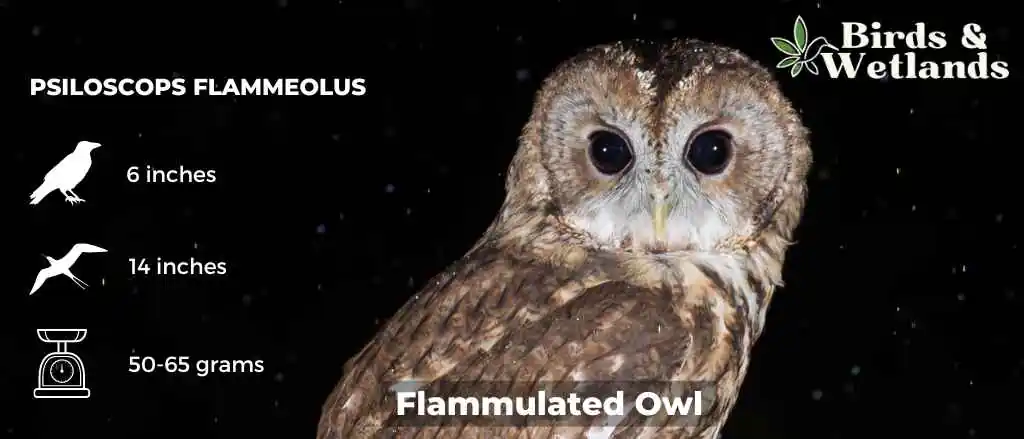
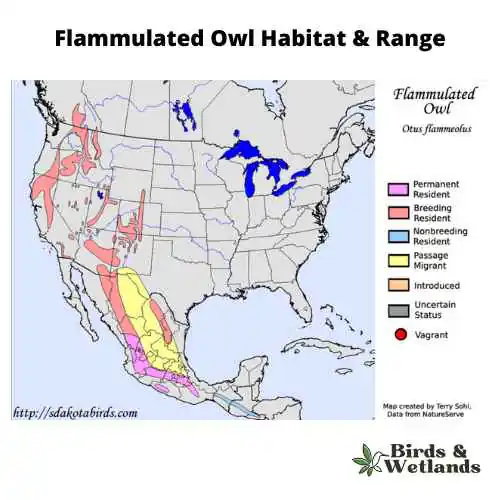
Flammulated Owl Sound
Scientific Name: Psiloscops flammeolus
Length: 6 in
Wingspan: 14 in
Weight: 1.8 – 2.3 oz
The Flammulated Owl is a small owl species native to North America, notable for its incredible migratory journeys, which may span thousands of miles.
Flammulated Owls name “flammulated” comes from the Latin word for flame, and it refers to their flame-like markings. These owls sport a mottled gray and rust color, with dark eye patches and a white throat. Their small size and cryptic plumage help them to blend into the bark of the trees in which they reside.
One of the defining traits of the Flammulated Owl is their diet they predominantly eat insects, particularly moths and beetles.
These owls prefer to nest in mature forests, often in old woodpecker holes or natural tree cavities. They typically lay 2-4 eggs, with the female incubating them for about three weeks, while the male provides food.
Flammulated Owls are known for their soft, low hooting call which can be difficult to hear. This, along with their excellent camouflage, often makes them challenging to spot, despite their widespread distribution.
Burrowing Owl (Athene cunicularia)
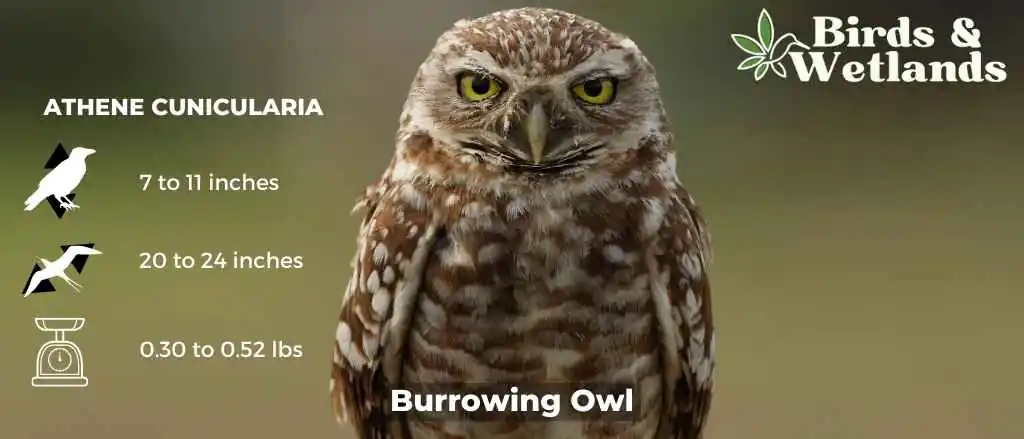

Burrowing Owl Sound
Scientific Name: Athene cunicularia
Length: 7–11 in
Wingspan: 20–24 in
Weight:5–8 oz
The Burrowing Owl is a small, long-legged species of owl found in North and South America. Known for its unusual habit of living in burrows in the ground.
Burrowing Owls have a rounded head with no ear tufts and bright yellow eyes. Their overall coloration is mottled brown and white with a distinct white “eyebrow” above each eye.
Their primary habitat includes open landscapes such as grasslands, deserts, agricultural areas, golf courses, and even airports. As their name suggests, these owls often reside in burrows, many of which are abandoned by prairie dogs, ground squirrels, or other burrowing animals. In some cases, they may also dig their own burrows.
Burrowing Owls diet consists mainly of small mammals and insects, but they also eat birds and reptiles.
Burrowing Owls have a unique nesting behavior. They lay their eggs in an underground burrow to protect them from predators and extreme weather. Clutch sizes range from 6 to 11 eggs, which are incubated for about a month before hatching.
Northern Hawk Owl (Surnia ulula)

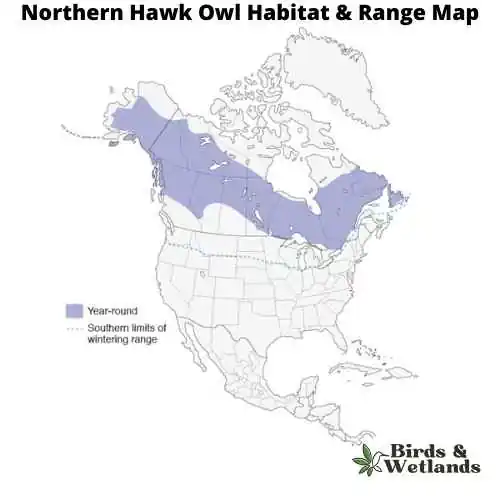
Northern Hawk Owl Sound
Scientific Name:Surnia ulula
Length: 14.2–17.6 in
Wingspan: 18 in
Weight: 11 oz-12 oz
The Northern Hawk Owl, is a medium-sized owl known for its daytime hunting habits and hawk-like behavior, hence its name.
Northern Hawk Owls are recognized by their elongated body, long tail, and lack of ear tufts – traits reminiscent of a hawk. Its plumage is generally dark brown, with white spots on the upper parts and streaks on the underparts. The owl’s face is marked by a white facial disc and distinctive black borders that make it appear somewhat masked.
Diet: consists of small mammals, such as voles, lemmings, and squirrels, but it has also been known to feed on smaller birds. The bird has an extraordinary vision that allows it to spot prey from up to 800 meters away, and it often hunts from a high perch, swooping down on its prey similar to a hawk.
Nesting typically occurs in tree cavities or abandoned nests of other birds. The female Northern Hawk Owl lays between 3 to 11 eggs and is responsible for incubation, while the male provides food and protection.
Where to Spot Montana’s Owls
Glacier National Park, West Glacier: Known for its impressive biodiversity, this park is home to several owl species, including Great Horned Owls, Northern Pygmy Owls, and Northern Saw-whet Owls.
Lee Metcalf National Wildlife Refuge, Stevensville: Situated in the Bitterroot River Valley, this refuge is a haven for a variety of birds. Look for Great Horned Owls, Western Screech Owls, and Northern Pygmy Owls.
Yellowstone National Park: This world-renowned park is a great place to spot Great Gray Owls, Great Horned Owls, and Northern Saw-whet Owls.
Charles M. Russell National Wildlife Refuge, Lewistown: This refuge offers a chance to see several owl species, including Great Horned Owls, Long-eared Owls, and Short-eared Owls.
Ninepipe National Wildlife Refuge, Charlo: Located in the Mission Valley, this refuge is a haven for birds. Here, you can find Great Horned Owls, Western Screech Owls, and Long-eared Owls.
| State | Main Owl Watching Site |
|---|---|
| Idaho Owls | Idaho Bird Watching Park |
| Wyoming Owls | Wyoming Owl Reserve |
| North Dakota Owls | North Dakota Bird Sanctuary |
| South Dakota Owls | South Dakota Owl Spot |
Tips on How to Spot Owls in Montana?
Locations: Visit owl-friendly habitats. This includes forested areas such as Bitterroot National Forest and Beaverhead-Deerlodge National Forest. Open grassland areas and along river corridors can also host certain species like the Burrowing Owl.
Timing: Owls are mostly nocturnal, so the best times to spot them are around dawn and dusk. However, during the breeding season (spring to early summer), some species may be active during daylight hours.
Listen for Calls: Owls use calls to communicate with mates, defend territory, or call their young. Learning these calls can help you locate owls even when they’re hidden.
Owl Signs: Look for owl pellets, or regurgitated clumps of undigested material, under trees or on ledges. This can indicate an owl’s presence even if you can’t see the bird itself.
Patience and Quiet: Owl-spotting often requires stillness and patience, as these birds can be sensitive to disturbances. It’s also essential to remain quiet to not disturb the owls.
Equipment: A pair of good-quality binoculars is essential for birdwatching. Since owls are primarily active at night, you might also consider a red-filtered flashlight to help spot them without disturbing their activity.
Birdwatching Groups: Consider joining local birdwatching groups or tours. They often have up-to-date information about owl sightings and can offer additional guidance.

